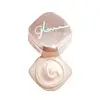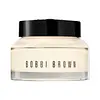What's inside
What's inside
 Key Ingredients
Key Ingredients

 Benefits
Benefits

 Concerns
Concerns

 Ingredients Side-by-side
Ingredients Side-by-side

Rosa Damascena Flower Water
MaskingButylene Glycol
HumectantHydrogenated Poly(C6-14 Olefin)
EmollientSqualane
EmollientGlycerin
HumectantCaprylic/Capric/Myristic/Stearic Triglyceride
EmollientButyrospermum Parkii Butter
Skin ConditioningCetearyl Alcohol
EmollientNiacinamide
SmoothingMacadamia Integrifolia Seed Oil
Skin ConditioningGlyceryl Stearate
EmollientPhytosteryl/Isostearyl/Cetyl/Stearyl/Behenyl Dimer Dilinoleate
Skin ConditioningCyclopentasiloxane
EmollientSynthetic Beeswax
Emulsion StabilisingPEG-40 Stearate
EmulsifyingCeramide AP
Skin Conditioning1,2-Hexanediol
Skin ConditioningWater
Skin ConditioningCyclohexasiloxane
EmollientPEG-100 Stearate
Caprylic/Capric Triglyceride
MaskingDimethicone
EmollientPEG-30 Dipolyhydroxystearate
EmulsifyingCaprylyl Glycol
EmollientPolyacrylamide
C13-14 Isoparaffin
EmollientNelumbo Nucifera Flower Extract
Skin ConditioningPrunus Mume Fruit Extract
HumectantSodium Polyacrylate
AbsorbentCopernicia Cerifera Wax
Tocopheryl Acetate
AntioxidantCitrus Aurantium Dulcis Peel Oil
MaskingCitrus Nobilis Peel Oil
MaskingEthylhexyl Cocoate
EmollientEthylhexylglycerin
Skin ConditioningPolyglyceryl-6 Stearate
EmollientDisodium EDTA
Laureth-7
EmulsifyingEclipta Prostrata Extract
Skin ConditioningHippophae Rhamnoides Oil
EmollientPPG-3 Benzyl Ether Myristate
EmollientCananga Odorata Flower Oil
MaskingCitrus Aurantium Amara Peel Oil
Skin ConditioningHydrolyzed Hibiscus Esculentus Extract
Skin ConditioningLupinus Albus Seed Extract
Skin ConditioningMoringa Oleifera Seed Extract
Skin ConditioningCitrus Reticulata Leaf Oil
MaskingPolysorbate 20
EmulsifyingMelia Azadirachta Leaf Extract
Skin ConditioningPolyglyceryl-6 Behenate
Emulsion StabilisingHelianthus Annuus Seed Oil Unsaponifiables
EmollientSimmondsia Chinensis Seed Oil
EmollientSodium Hyaluronate
HumectantMoringa Oleifera Seed Oil
EmollientTocopherol
AntioxidantXylitylglucoside
HumectantAnhydroxylitol
HumectantXylitol
HumectantHydrogenated Lecithin
EmulsifyingGlucose
HumectantGlycine
BufferingSerine
MaskingGlutamic Acid
HumectantCeramide NP
Skin ConditioningHydrolyzed Collagen
EmollientAspartic Acid
MaskingLeucine
Skin ConditioningAlanine
MaskingLysine
Skin ConditioningArginine
MaskingTyrosine
MaskingPhenylalanine
MaskingProline
Skin ConditioningThreonine
Valine
MaskingIsoleucine
Skin ConditioningHistidine
HumectantCysteine
AntioxidantMethionine
Skin ConditioningRosa Damascena Flower Water, Butylene Glycol, Hydrogenated Poly(C6-14 Olefin), Squalane, Glycerin, Caprylic/Capric/Myristic/Stearic Triglyceride, Butyrospermum Parkii Butter, Cetearyl Alcohol, Niacinamide, Macadamia Integrifolia Seed Oil, Glyceryl Stearate, Phytosteryl/Isostearyl/Cetyl/Stearyl/Behenyl Dimer Dilinoleate, Cyclopentasiloxane, Synthetic Beeswax, PEG-40 Stearate, Ceramide AP, 1,2-Hexanediol, Water, Cyclohexasiloxane, PEG-100 Stearate, Caprylic/Capric Triglyceride, Dimethicone, PEG-30 Dipolyhydroxystearate, Caprylyl Glycol, Polyacrylamide, C13-14 Isoparaffin, Nelumbo Nucifera Flower Extract, Prunus Mume Fruit Extract, Sodium Polyacrylate, Copernicia Cerifera Wax, Tocopheryl Acetate, Citrus Aurantium Dulcis Peel Oil, Citrus Nobilis Peel Oil, Ethylhexyl Cocoate, Ethylhexylglycerin, Polyglyceryl-6 Stearate, Disodium EDTA, Laureth-7, Eclipta Prostrata Extract, Hippophae Rhamnoides Oil, PPG-3 Benzyl Ether Myristate, Cananga Odorata Flower Oil, Citrus Aurantium Amara Peel Oil, Hydrolyzed Hibiscus Esculentus Extract, Lupinus Albus Seed Extract, Moringa Oleifera Seed Extract, Citrus Reticulata Leaf Oil, Polysorbate 20, Melia Azadirachta Leaf Extract, Polyglyceryl-6 Behenate, Helianthus Annuus Seed Oil Unsaponifiables, Simmondsia Chinensis Seed Oil, Sodium Hyaluronate, Moringa Oleifera Seed Oil, Tocopherol, Xylitylglucoside, Anhydroxylitol, Xylitol, Hydrogenated Lecithin, Glucose, Glycine, Serine, Glutamic Acid, Ceramide NP, Hydrolyzed Collagen, Aspartic Acid, Leucine, Alanine, Lysine, Arginine, Tyrosine, Phenylalanine, Proline, Threonine, Valine, Isoleucine, Histidine, Cysteine, Methionine
Water
Skin ConditioningCyclopentasiloxane
EmollientBis-Diglyceryl Polyacyladipate-2
EmollientButylene Glycol
HumectantPPG-2 Myristyl Ether Propionate
EmollientCetyl Alcohol
EmollientPEG-40 Stearate
EmulsifyingButyrospermum Parkii Butter
Skin ConditioningSqualane
EmollientGlyceryl Stearate
EmollientSorbitan Stearate
EmulsifyingEpilobium Angustifolium Extract
Skin ConditioningYeast Extract
Skin ConditioningBeta-Carotene
Skin ConditioningSodium Hyaluronate
HumectantCitrus Grandis Peel Oil
MaskingTocopheryl Acetate
AntioxidantMethyl Glucose Sesquistearate
EmollientPelargonium Graveolens Flower Oil
MaskingDimethicone Crosspolymer
Emulsion StabilisingAcrylates/C10-30 Alkyl Acrylate Crosspolymer
Emulsion StabilisingCarbomer
Emulsion StabilisingPEG-20 Methyl Glucose Sesquistearate
EmulsifyingC12-15 Alkyl Ethylhexanoate
EmollientTetrasodium EDTA
Sodium Hydroxide
BufferingPanthenol
Skin ConditioningMagnesium Ascorbyl Phosphate
AntioxidantLimonene
PerfumingCitronellol
PerfumingGeraniol
PerfumingLinalool
PerfumingChlorphenesin
AntimicrobialPhenoxyethanol
PreservativeWater, Cyclopentasiloxane, Bis-Diglyceryl Polyacyladipate-2, Butylene Glycol, PPG-2 Myristyl Ether Propionate, Cetyl Alcohol, PEG-40 Stearate, Butyrospermum Parkii Butter, Squalane, Glyceryl Stearate, Sorbitan Stearate, Epilobium Angustifolium Extract, Yeast Extract, Beta-Carotene, Sodium Hyaluronate, Citrus Grandis Peel Oil, Tocopheryl Acetate, Methyl Glucose Sesquistearate, Pelargonium Graveolens Flower Oil, Dimethicone Crosspolymer, Acrylates/C10-30 Alkyl Acrylate Crosspolymer, Carbomer, PEG-20 Methyl Glucose Sesquistearate, C12-15 Alkyl Ethylhexanoate, Tetrasodium EDTA, Sodium Hydroxide, Panthenol, Magnesium Ascorbyl Phosphate, Limonene, Citronellol, Geraniol, Linalool, Chlorphenesin, Phenoxyethanol
 Reviews
Reviews

Ingredients Explained
These ingredients are found in both products.
Ingredients higher up in an ingredient list are typically present in a larger amount.
Butylene Glycol (or BG) is used within cosmetic products for a few different reasons:
Overall, Butylene Glycol is a safe and well-rounded ingredient that works well with other ingredients.
Though this ingredient works well with most skin types, some people with sensitive skin may experience a reaction such as allergic rashes, closed comedones, or itchiness.
Learn more about Butylene GlycolThis ingredient is also known as shea butter. It is an effective skin hydrator and emollient.
Emollients help soothe and soften your skin. It does this by creating a protective film on your skin. This barrier helps trap moisture and keeps your skin hydrated. Emollients may be effective at treating dry or itchy skin.
Shea butter is rich in antioxidants. Antioxidants help fight free-radicals, or molecules that may harm the body. It is also full of fatty acids including stearic acid and linoleic acid. These acids help replenish the skin and keep skin moisturized.
While Shea Butter has an SPF rating of about 3-4, it is not a sunscreen replacement.
Shea butter may not be fungal acne safe. We recommend speaking with a professional if you have any concerns.
Learn more about Butyrospermum Parkii ButterCyclopentasiloxane, or D5, is a silicone used to improve texture of products and trap moisture.
D5 is considered lightweight and volatile. Volatile means it evaporates quickly after application. Once evaporated, D5 leaves a thin barrier that helps keep skin hydrated.
It is also an emollient. Emollients help soften the skin and prevent water loss. Silicones create a silky texture in products. D5 helps other ingredients become more spreadable.
Studies show D5 is safe to use in skincare products. We recommend speaking with a skincare professional if you have concerns.
Learn more about CyclopentasiloxaneGlyceryl Stearate is a mix of glycerin and stearic acid.
It is used to stabilize the mixing of water and oil ingredients. By preventing these ingredients from separating, it can help elongate shelf life. It can also help thicken the product's texture.
As an emollient, it helps soften skin and supports barrier-replenishing ingredients.
In cosmetics, Glyceryl Stearate is often made from vegetable oils or synthetically produced.
This ingredient may not be fungal-acne safe
Fun fact: The human body also creates Glyceryl Stearate naturally.
Learn more about Glyceryl StearatePeg-40 Stearate is a waxy solid made up of polyethylene glycol and stearic acid. It is an emulsifier and cleanser. Emulsifiers help oils and water mix.
Stearic acid is a a fatty acid. Therefore, Peg-40 stearate may not be fungal-acne safe.
Sodium Hyaluronate is hyaluronic acid's salt form. It is commonly derived from the sodium salt of hyaluronic acid.
Like hyaluronic acid, it is great at holding water and acts as a humectant. This makes it a great skin hydrating ingredient.
Sodium Hyaluronate is naturally occurring in our bodies and is mostly found in eye fluid and joints.
These are some other common types of Hyaluronic Acid:
Learn more about Sodium HyaluronateSqualane is an emollient that helps the skin hold onto moisture. It's an oily liquid that occurs naturally in certain types of fish and plant oils.
Because squalane boosts hydration in the skin, it also comes with plenty of benefits: it is an antioxidant and can help fight free radicals and skin damage. Squalane is also found to have a detoxifying effect when applied.
Squalane comes from squalene, which occurs naturally within the sebum of our skin. It is one of the oils our skin produces to keep itself hydrated. Squalane is the hydrogenated version of squalene and has a longer shelf life.
Research shows that squalane is non-irritating (even at 100% concentration).
In general, it's a fantastic ingredient. It does a great job at hydrating the skin, and it's suitable for those with sensitive skin.
The source of squalane may impact malassezia / fungal acne. This is because olive oil derived squalane can contain impurities such as fatty acids and plant waxes. Sugarcane derived squalane is recommended for anyone with malassezia concerns.
Is squalane vegan?
This depends on the source. Squalane can be derived from both plants and animals. Most squalane used in skincare comes from plants.
Please note: the source of squalane is only known if disclosed by the brand. We recommend reaching out to the brand if you have any questions about their squalane.
Read more about squalene with an "e".
Is squalane an oil?
Squalane is often called an oil, but it’s technically not; it’s a hydrocarbon, meaning it’s only made of carbon and hydrogen, unlike true oils which are triglycerides made of fatty acids and glycerol.
The term “oil-free” isn’t regulated, so companies can define it however they want. Some exclude all oils, while others just avoid mineral oil or comedogenic oils.
While some people avoid oils thinking they cause breakouts, the right kind of oil (or oil-like ingredient like squalane) can actually help balance and hydrate your skin. It’s worth testing out simple oils or squalane to see what works best for your skin.
Learn more about SqualaneTocopheryl Acetate is AKA Vitamin E. It is an antioxidant and protects your skin from free radicals. Free radicals damage the skin by breaking down collagen.
One study found using Tocopheryl Acetate with Vitamin C decreased the number of sunburned cells.
Tocopheryl Acetate is commonly found in both skincare and dietary supplements.
Learn more about Tocopheryl AcetateWater. It's the most common cosmetic ingredient of all. You'll usually see it at the top of ingredient lists, meaning that it makes up the largest part of the product.
So why is it so popular? Water most often acts as a solvent - this means that it helps dissolve other ingredients into the formulation.
You'll also recognize water as that liquid we all need to stay alive. If you see this, drink a glass of water. Stay hydrated!
Learn more about Water